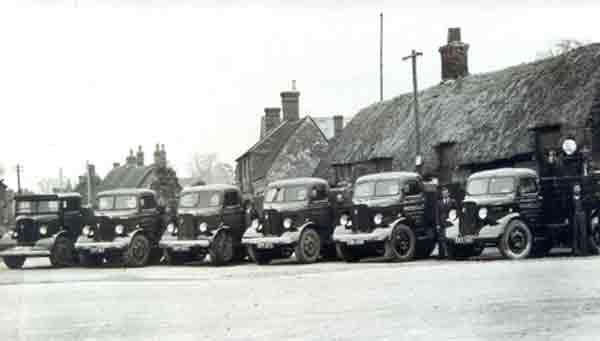The following extract comes from Phyllis Loxley-Walton's book, "A Walk Around Sherington"
Haynes & Co. Sherington Ltd.
and
Sherington Haulage Co. Ltd.

The business was started about 1923, at first in what was called the Sherington Reading room, which had a thatched roof and was joined to another cottage occupied at that time by Mr and Mrs Warren and family who later moved out . Their house and backyard was then added to the reading room.
Petrol at that time was supplied in two gallon cans with a limit to the number of cans which could be kept in the garage. The remaining cans were kept in a store at No.1 Council house in Church Road where my parents moved to in 1921. About 1923 we took over a small cycle shop in Newport Pagnell next door to the Co-op butchers shop. At that time we had obtained our first lorry, which was a second-hand ex W.D. Crosslev. In addition we had a three-tonner on solid tyres. This could only travel at twenty miles per hour and worked from the gravel pits along the Newport Pagnell Road. By 1925 the haulage had been increased to four lorries, all of which were the tipping type, worked by hand. These lorries were engaged mostly in road maintenance, hauling ‘tarmac' which was used instead of dry stone and dirt. The cycle shop was transferred to No.66, High Street, Newport Pagnell, opposite the Post Office now occupied by Boots the Chemist. Opening hours were from 8 am. to 1pm and 2 pm. to 7pm. from Monday to Wednesday, Thursdays mornings only, with Friday and Saturdays until 8pm.
It was at that time when my Father went into partnership with my uncle who lived at Linslade. Being a cabinet maker by trade he carried out general repair work in the village.
During the same period, the BBC started to transmit regular broadcasting from Daventry. This could be picked up on a crystal set with headphones. A BBC licence costing 10/- had to be obtained for the set, which required an outside, insulated aerial. Our licence cost 15/- to construct the sets at home. Nearly every house in the village had one of these sets.
In 1927 I took over the Newport cycle shop where I remained until 1930 when my uncle then took over. I changed to lorry driving in 1935 when we obtained our first new lorry, a 4/5 ton Dodge costing about £400. This had to have a body and hydraulic tipping gear fitted.
By 1935 we had purchased our sixth new lorry. The carrying capacity had by then gone up to 6/7 tons. We used to carry out all our own repairs and engine reconditioning, as well as boring and sleeving.
My father dissolved partnership with my uncle, who took over the Newport shop, and my father retaining the Sherington business.
Towards the end 1937 we began to vacate the premises at The Knoll and moved to Church Road where Mr G. Hine carried on a business as wheelwright. The site on The Knoll was cleared and rebuilding started.
We returned to the building about March 1939. At this time, most of the lorries were engaged in aerodrome runway building, carting ‘tarmac', sand and ballast; three lorries being engaged in carting sand and ballast from Marlow Bottom to Walters Ash. The loads were tipped in a wood and at that time we never knew where it went to, but after the war we found out that it was used for an underground control centre for the RAF.
War broke out on Sunday 3rd of September 1939, but most of our employees, being in a reserved occupation, remained with us until they were called up. My brother was the first to go, being called up in the Militia in March 1949. By the end of 1941 most of our of young drivers had been called up and it was difficult to obtain labour. Petrol was rationed and parts were difficult to obtain, unless you were engaged on some kind of war work. I was called up with the tradesmen in September l942. This left my father on his own in the garage.
As the lorries were all engaged on airport building and maintenance, after a time my father had labour directed to him, one man coming from London. He used to journey here on Monday mornings and return home on Saturday evenings.
I was released from the army during December 1945 arriving home about two days before Christmas. It was some time before we could purchase new lorries. Our type of haulage had changed. We were now carrying bricks, cereals, fertiliser, bulk wheat and battery hen cereals. This was blown into the silos so they needed special equipment and bodywork.
My brother had now taken over the running of the lorries. We were changing over from Dodge lorries to Fodens four, six and eight-wheelers. We bought our first Foden in 1960 and during its first year of operation it covered 63,000 miles. By 1963 we had obtained our fourth Foden.
During this period we had to make an application to the Licensing Authority for a licence to operate. These were mostly objected to by British Railways; we had then to make representation and reasons for requiring a licence. All this work was carried out by my sister, who was secretary of both Limited Companies.
Both businesses are still in operation, run by the third and fourth generations of the family.
Tom Haynes
The Knoll
11th Jan 1988